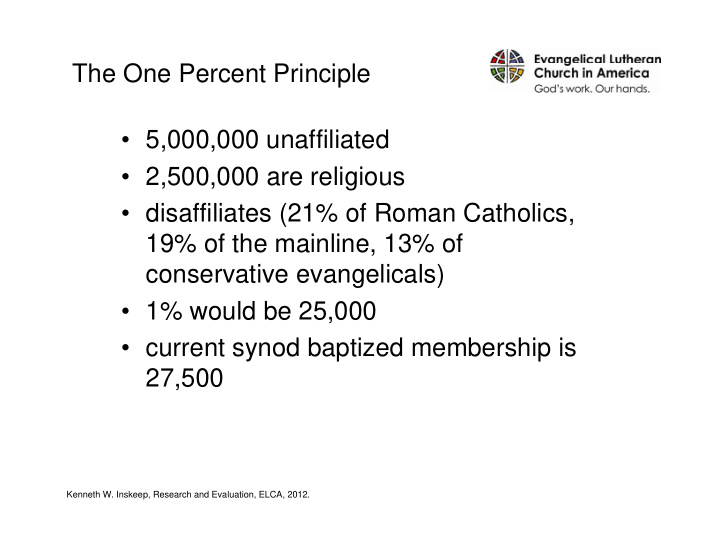



The One Percent Principle • 5,000,000 unaffiliated • 2,500,000 are religious • disaffiliates (21% of Roman Catholics, 19% of the mainline, 13% of conservative evangelicals) • 1% would be 25,000 • current synod baptized membership is 27,500 Kenneth W. Inskeep, Research and Evaluation, ELCA, 2012.
Characteristics of The Unaffiliated • Religious people are hypocritical, judgmental and insincere. • Religions are partly true, but none are completely true. • Religious organizations are too focused on rules, not spirituality. • Religious leaders want money and power. • Religious people are anti-science. Kenneth W. Inskeep, Research and Evaluation, ELCA, 2012.
Theologically Atypical • Religious people are hypocritical, judgmental and insincere. • Religions are partly true, but none are completely true. • Religious organizations are too focused on rules, not spirituality. • Religious leaders want money and power. • Religious people are anti-science. Kenneth W. Inskeep, Research and Evaluation, ELCA, 2012.
Congregational Vitality • Building and strengthening relationships between members (participants) and God (worship, spiritual growth and faith practices) • Building and strengthening relationships (internal) among members (caring and supportive) • Building and strengthening relationships between members and the community (external) (evangelism, social justice, local and global community service). Kenneth W. Inskeep, Research and Evaluation, ELCA, 2012.
Congregational Vitality The factors that influence a congregation's missional vitality are well known. Congregations with missional vitality have a widely shared commitment to reaching out into the community and a willingness to change as a means of reaching out. These characteristics are the product of strong adult faith formation programs that stress faith practices and spiritual growth. Kenneth W. Inskeep, Research and Evaluation, ELCA, 2012.
A Method to Change (Part I) Because people are set in their ways, change begins with defining a clear, positive direction. This often means moving away from trying to fix a problem and moving toward better understanding what is already working. Kenneth W. Inskeep, Research and Evaluation, ELCA, 2012.
A Method to Change (Part II) Change happens when it engages people's hearts and their emotions. People often know what they should do, but it is more comfortable emotionally (at least in the short-run) to follow habit. Change is hard because it goes against what is emotionally the easiest thing to do. Kenneth W. Inskeep, Research and Evaluation, ELCA, 2012.
Identity vs. Costs/Benefit Who are we as a congregation and who does God want us to be? 1. What does listening to scripture tell us about ourselves and about God? 2. What do our traditions tell us about ourselves and God? 3. What does listening to our neighbors and our communities tell us about the community and ourselves? 4. What is God calling us as a congregation to do in this situation as we participate in God's mission? Kenneth W. Inskeep, Research and Evaluation, ELCA, 2012.
A Method to Change (Part III) It is important to shape (re-shape ) the environment. Kenneth W. Inskeep, Research and Evaluation, ELCA, 2012.
Competencies • strategic thinking • new technologies, • leader development, • a missional focus, • cooperative ministries among congregations, • global relationships, • resource development (financial campaigns), • youth and young adult ministry, • conflict (most recently the aftermath of the sexuality decision), • interpretation Kenneth W. Inskeep, Research and Evaluation, ELCA, 2012.
The Message • Jesus is given to us as a gift from God. We come to know this gift through faith which according to Luther is nothing more or less than a "living, daring confidence" in the graciousness of God, "so certain that you could stake your life on it one thousand times". • According to Luther this kind of trust in and knowledge of God will make us "joyful, confident and happy with regard to God and all creatures". According to Luther "through faith, a person will do good to everyone without coercion, willingly and happily; serving everyone, suffering everything for the love and praise of God, who has shown such grace". Kenneth W. Inskeep, Research and Evaluation, ELCA, 2012.
The Church We Want to Be • We want to be a church that belongs to Christ with a place for everyone. • We want to be a church whose unity is in Jesus, who gathers us around word and water, wine and bread. • We want to be a church that believes Jesus is God’s “yes” to us and that our lives can be a “yes” to others. • We want to be a church that believes God is calling us into the world--together (a church that rolls up its sleeves and gets to work (restoring and reconciling communities). Kenneth W. Inskeep, Research and Evaluation, ELCA, 2012.
The Church We Want to Be • We want to be a church that is a catalyst, convener and bridge builder. • We want to be a church that is energized by lively engagement in our faith and life (continually striving for a deeper understanding of what the death and resurrection of Jesus Christ means for the world.) • We want to be a church that is deeply rooted and always being made new. Kenneth W. Inskeep, Research and Evaluation, ELCA, 2012.
Recommend
More recommend